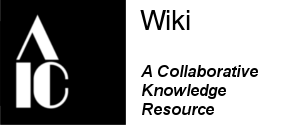Lippmann Process (Interferential Color Process)
| Page Information | |
| Date initiated | February 2025 |
| Contributors | Luisa Casella |
Lippmann Process[edit | edit source]
The Lippmann process is an interferential color process that records colors through the interference of light waves. It presents as a plate with a glass prism over it. Gabriel Lippmann introduced the interferential color photography process in 1891, presenting it to the French Académie des Sciences. This technique records colors by creating interference patterns within the photosensitive plate, capturing the colors of the subject without the use of pigments or dyes. In recognition of this groundbreaking work, Lippmann was awarded the Nobel Prize in Physics in 1908[1].
Historical Facts[edit | edit source]
Patented[edit | edit source]
While specific patent details are not readily available, Lippmann's method was widely recognized and discussed in scientific communities following its introduction in 1891.
Important Development Dates[edit | edit source]
- 1891: Gabriel Lippmann presents his color photography process to the French Académie des Sciences.
- 1908: Lippmann receives the Nobel Prize in Physics for his method of reproducing colors photographically based on the phenomenon of interference.
Alternate Names[edit | edit source]
- Interferential Color Photography
- Lippmann Process
- Lippman Plate
- Interference Photograph
Historic Practitioners[edit | edit source]
- Gabriel Lippmann: The inventor of the process.
- Richard Neuhauss: A German photographer who produced notable Lippmann plates, including an 1899 image of a stuffed parrot.
- Hans Lehmann: German photographer known for his work with the Lippmann process.
Identification Characteristics[edit | edit source]
Image layer[edit | edit source]
Fine-grain silver halide emulsion on a glass plate. Initially albumen binder, later using gelatin emulsion.
Color[edit | edit source]
Vivid and accurate color reproduction achieved through interference patterns, without the use of dyes or pigments.
Support[edit | edit source]
Glass plate.
Viewing System[edit | edit source]
Image layer glass was coated with black paint.
Image side of plate was adhered to a 10 degree viewing glass prism using Canada balsam.
Basic Process Overview[edit | edit source]
The Lippmann process involves exposing a photosensitive plate in contact with a highly reflective surface, originally mercury. Light waves reflect back into the emulsion, creating standing waves that form interference patterns corresponding to specific colors. Upon development, these patterns reconstruct the original colors when viewed under appropriate lighting conditions.
- Preparation: A glass plate is coated with an ultra fine-grain photosensitive emulsion.
- Exposure: The plate is placed in the camera with the emulsion facing a reflective surface (initially mercury). Light from the subject enters, reflects off the surface, and creates interference patterns within the emulsion.
- Development: The plate is developed using standard photographic chemicals, fixing the interference patterns.
- Viewing: The developed plate displays the captured colors when illuminated and viewed at specific angles, through a 10 degree abgle glass prism..
Housing and Storage[edit | edit source]
Lippmann plates are rare. They should be stored in a dark stable environment with controlled temperature and humidity.
Emergency Recovery[edit | edit source]
No data has been found on specific emergency recovery steps for these materials. They are most likely rare so should be in the fisrt line for immediate response.
Current Scholars, Researchers, Experts and Practitioners[edit | edit source]
Conservators[edit | edit source]
- Anna Giatti: Conservator at Fondazione Scienza e Tecnica in Florence, involved in the study and conservation of a Lippmann plate housed in the institution.
- Jens Gold: Photograph conservator at Preus Museum in Norway, specializes in the materiality, identification, and conservation of Lippmann plates.
Researchers and Scholars[edit | edit source]
- Hans I. Bjelkhagen: Focuses on modern Lippmann photography techniques and has contributed to the revival of the process.
- Dr. Hanin Hannouch: Curator and researcher who has extensively studied and curated exhibitions on Lippmann's interferential color photography.
Current Practitioners[edit | edit source]
Relevant Collections[edit | edit source]
- Preus Museum (Norway): Houses a collection of Lippmann plates, including works by Richard Neuhauss and Hans Lehmann.
- Musée de l'Elysée (Switzerland): Holds an extensive collection of Lippmann's original plates.
Important Exhibitions[edit | edit source]
- "Slow Color Photography" at Preus Museum: Held from August 28, 2021, to January 30, 2022, this exhibition explored the Lippmann process and its significance in the history of color photography.
Further Reading[edit | edit source]
- Hannouch, Hanin, editor. Gabriel Lippmann's Colour Photography: Science, Media, Museums. Amsterdam University Press, 2022.
- Popular Photography. "How to Make a Lippmann Color Plate." Popular Photography, 25 July 2022, www.popphoto.com/how-to/lippmann-process/. Accessed 10 May 2025.
References[edit | edit source]
- ↑ Hannouch, Hanin, editor. Gabriel Lippmann's Colour Photography: Science, Media, Museums. Amsterdam University Press, 2022, https://doi.org/10.2307/j.ctv2r4kxgt.
| Copyright 2025. Photographic Materials Group Wiki is a publication of the Photographic Materials Group of the American Institute for Conservation. It is published as a convenience for the members of thePhotographic Materials Group. Publication does not endorse nor recommend any treatments, methods, or techniques described herein. Please follow PMG Wiki guidelines for citing PMG Wiki content, keeping in mind that it is a work in progress and is frequently updated.
|
Back to Photographic Materials Main Page
Back to PMG Photographic Processes



